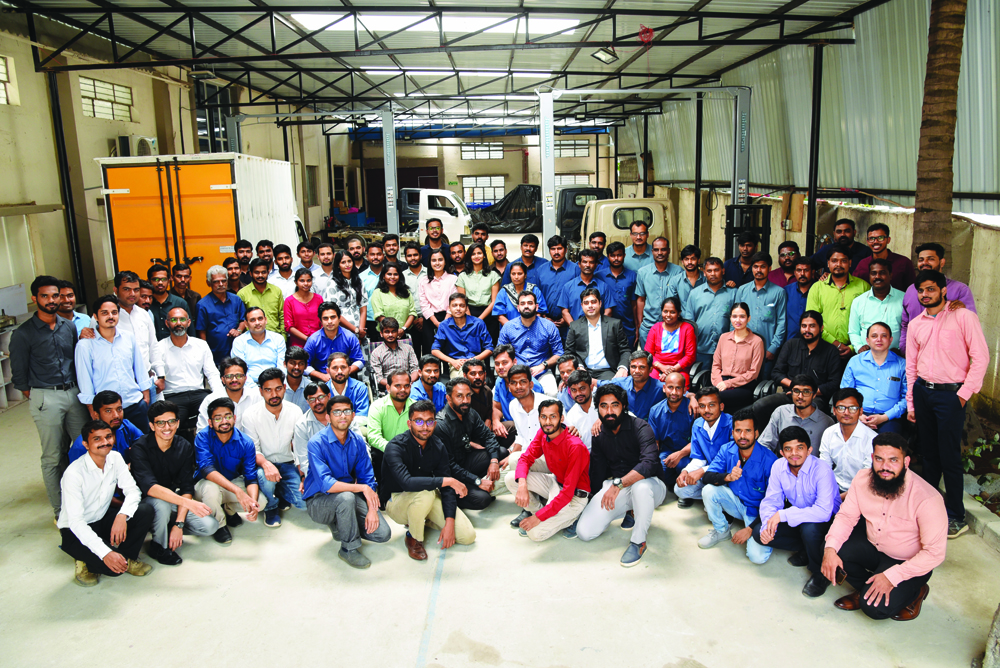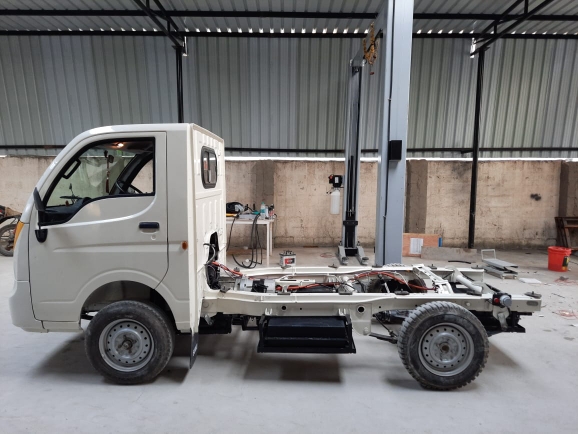Stepping up the Auto Game

Enabled by in-house developed technology and products, Bangalore-based mobility technology company CellProp Pvt Ltd aims to design and produce the most advanced, class-leading electric commercial vehicles and work on solving the hurdles that logistics companies face in their large-scale adoption.
A mobility technology company based out of Bengaluru, Karnataka, CellProp Pvt Ltd finds its origins in the idea of electrifying large commercial vehicle fleets for India to accelerate its transition towards net-zero emissions.
“In India, more than 80 percent of freight is moved by CVs (Commercial Vehicles). Hence, their large-scale electrification will not just reduce emissions but also India’s diesel imports,” points out Nakul Kukar, Founder & CEO, CellProp Pvt Ltd.
The company is focused on the design & development of Electric Commercial Vehicles (eCVs) – Electric Light Commercial Vehicles (eLCVs) and Electric Heavy Commercial Vehicles (eHCVs). These eCVs are deployed as part of its end-to-end solution, which solves all the pain points associated with the adoption of electric mobility.
 Things in process
Things in process
Currently, the company is deploying eLCVs with a 1-tonne payload to an initial set of customers. These eLCVs are re-manufactured vehicles that are built from the ground up in its facility using battery packs and BMS developed and manufactured in-house. The battery pack has a modular design with each module of 24V, 6kWh capacity and is AIS-48 certified. “As our production capacity grows, we will indigenize the production of electric motors and drives as well. The eLCV has a range of 150km (24kWh battery, 30kW peak power) and is presently being deployed with logistics companies in Bangalore,” shares Kukar.
He adds, “Our eHCV platform is currently under development and is suitable for eTrucks up to 20T GVW. It delivers 200kW peak power and 250km range with a 600V, 300kWh in-house developed and produced battery packs and BMS. The pack will soon be certified for AIS-48, and subsequently, the eHCV will be sent for certification.”
All of the company’s CVs have 4G/LTE connectivity, and the data acquired from the operation of these vehicles is uploaded to its Mobility Platform. The mobility platform is an integrated software platform to process the acquired data to offer analytics and a host of value-added services like OTA updates, health monitoring, energy management, charge scheduling, etc. to Cell Propulsion customers.
The start of the journey
Cell Propulsion was founded by Kukar, Paras Kaushal, and Supratim Naskar. Before CellProp, Kukar and Kaushal worked at the Indian Space Research Organization (ISRO) on its launch vehicle rocket engine systems. At the time, Naskar, Chief Technical Officer (CTO) of the company, was working on launch vehicle payload fairings and mechanisms.
Kukar and Paras Kaushal, COO & Co-Founder of the company, had also worked with an aerospace startup on the design & development of lunar lander systems and the design & development of solar-powered electric aircraft. While working on the electric aircraft project, they realized that the electrification of ground vehicles represented a massive opportunity in India. Given the experience gained with EV technology and prior experience in managing complex engineering projects, they decided to initiate this venture.
The company started full-time operations in 2017 with the goal of designing and producing electric commercial vehicles (eLCVs and eHCVs). During the initial years, the Founders were involved in the design & development of core technology and powertrain components like battery packs, BMS, motors, drives, etc. Subsequently, they worked on integrating all these discrete components into powertrain systems for eLCVs and eHCVs. “Our initial goal was to sell eCVs to logistics companies. But upon realizing various systemic challenges involved in their adoption, we began to focus on building the complete ecosystem to accelerate the adoption and make the transition for logistics companies to electric highly seamless,” shares Kukar.
Currently, the company is deploying eLCVs with a 1-tonne playload to an initial set of customers. These eLCVs are re-manufactured vehicles that are built from the ground up in its facility using battery packs and BMS developed and manufactured in-house.
While Kukar sees fundraising, investor interactions, business development, and formulating the overall strategy and vision for the company, Kaushal is responsible for managing company operations and overseeing the general administration, infrastructure development, HR, Finance & Accounts, Compliance, and Supply Chain. Naskar, on the other hand, looks at leading technology and product development for electric powertrains and eCVs.
The company is backed by some of the largest early-stage VCs in the Indian ecosystem. “Some of our major investors are Endiya Partners, growX Ventures, and Micelio Mobility Fund. We have raised around US$3 million cumulatively across all our equity financing rounds and more than US$1 million in debt financing,” he adds.
Hurdles on the way
Revealing the key challenges the startup currently faces, Kukar explains, “Due to lack of local production, global supply chain disruptions caused by the pandemic, and a global semiconductor shortage, supply chain and inventory management has become an issue.”
The availability of skilled talent to build high-voltage, high-power equipment for eHCVs is another problem, he acknowledges.

When asked how the company copes with the competition in the field, Kukar responds, “The key to competing in the CV segment is to offer the most advanced features in our eCVs and make them category-leading products for the customers. Some such features are payload capacity, range, starting torque, etc. Offering the best specifications for these features at a reasonable price is being achieved by us through in-house technology development and massive vertical integration.”
Cell Propulsion also offers a host of digital solutions and services to operate and manage eCVs efficiently. This enables the consistent performance of its products and increases savings for its customers during the entire product life-cycle. “We believe that such end-to-end fully-managed approach to support the operation of eCVs will also offer a strong competitive advantage to us,” he notes.
Why electrify CVs?
Shedding light on the need for electrification of CVs in India to promote the larger adoption of EVs in the country, Kukar says, “In India, the large-scale electrification of CVs will help reduce diesel consumption to such an extent that fuel price fluctuations will stop impacting the price of goods for the common man. It will also reduce India’s diesel imports. Also, CVs are the largest source of vehicular pollution due to their low mileage diesel engines and the way they are driven. Their electrification will naturally have a massive impact on air pollution and air particulate levels.”
Another driver for the electrification of CVs, he adds, is a surge in demand for the delivery of goods within large cities due to the boom in e-commerce, which means increased demand for LCVs. Meeting this demand with eLCVs will also enable logistics companies to deliver on their sustainability goals while reducing their operating costs.
In India, the Goods Carrier segment sees the highest vehicle usage, which makes the CV segment ideal for leading the transition to electric due to a robust economic case.
“It is encouraging to see that the Government is taking necessary steps to create awareness and encourage the adoption of EVs. The policies from various state governments are also promising and are getting developed on an incentive-led model that will enable both manufacturers and consumers. The modification of the FAME II policy is a significant step forward for the e2W to encourage localization and increase affordability. We anticipate similar incentives for eCVs, as this segment is the largest producer of emissions and the largest consumer of diesel. The announcement of such incentives will further accelerate the adoption of eCVs in India,” informs Kukar.
 EV ecosystem in India
EV ecosystem in India
Kukar gets candid about the EV ecosystem in India for the commercial and logistics segments and reveals what he thinks is needed to improve it. He says, “In India, the Goods Carrier segment sees the highest vehicle usage, which makes the CV segment ideal for leading the transition to electric due to a robust economic case. This has led to many new players entering the CV industry with their eCV products. However, almost all of these new entrants are developing commercial e2W and e3W with just one or two players focusing on eLCVs (e4W) and eHCVs.”
According to him, the eCV ecosystem in India is at an early stage with massive growth potential. “This positions Cell Propulsion perfectly in this segment with a strong first-mover advantage. We believe that this growth will truly be realized in coming years with the announcement of Government incentives for eCVs, resulting in their wider adoption,” he adds.
Plans ahead
He concludes with the team’s vision for Cell Propulsion, which is to become the pioneer in the electrification of CVs and lead the deployment of eCVs on Indian roads. “Enabled by in-house developed technology and products, we aim to design and produce the most advanced, class-leading eCVs while also working on solving all the hurdles that logistics companies face in the large-scale adoption of eCV fleets. Finally, we intend to expand our operations outside of Bangalore to other Tier-1 and metropolitan cities.”

Poonam Pednekar
Chief Copy Editor
Magic Wand Media Inc
poonam.pednekar@magicwandmedia.in
Source: CellProp Pvt Ltd



 Facebook
Facebook.png) Twitter
Twitter Linkedin
Linkedin Subscribe
Subscribe